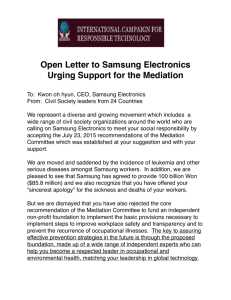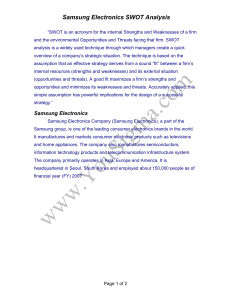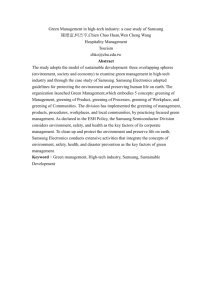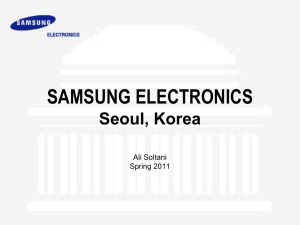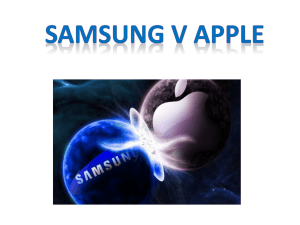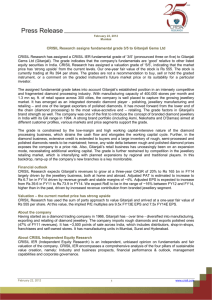Rating Scan Articles-March.p65
advertisement
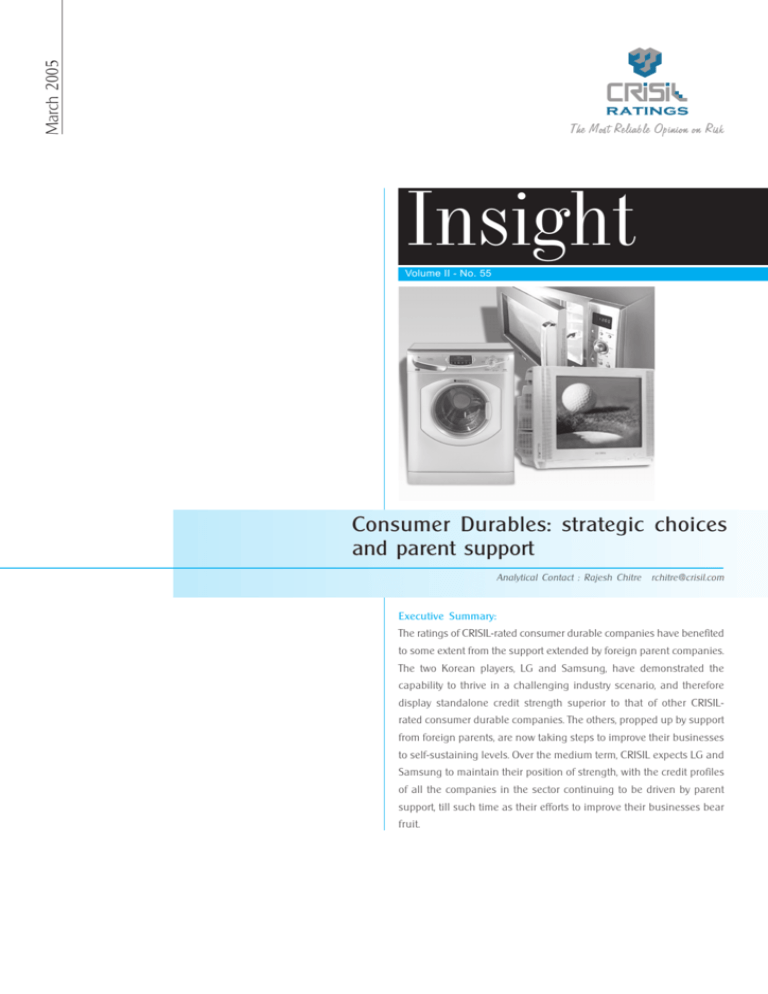
March 2005 Insight Volume II - No. 55 Consumer Durables: strategic choices and parent support Analytical Contact : Rajesh Chitre rchitre@crisil.com Executive Summary: The ratings of CRISIL-rated consumer durable companies have benefited to some extent from the support extended by foreign parent companies. The two Korean players, LG and Samsung, have demonstrated the capability to thrive in a challenging industry scenario, and therefore display standalone credit strength superior to that of other CRISILrated consumer durable companies. The others, propped up by support from foreign parents, are now taking steps to improve their businesses to self-sustaining levels. Over the medium term, CRISIL expects LG and Samsung to maintain their position of strength, with the credit profiles of all the companies in the sector continuing to be driven by parent support, till such time as their efforts to improve their businesses bear fruit. March 2005 Ratings driven by Parent Support: companies in this sector goes into advertising expenditure. This The Indian consumer durable industry has witnessed the growing expenditure, coupled with the need to service and maintain extensive dominance of the Korean companies, LG Electronics India Pvt Ltd distribution networks, results in low operating margins. (LG) and Samsung India Electronics Ltd (Samsung) over the last two to three years. While the strengthening business profiles of the Koreans reflect in the high investment grade ratings assigned to them, the performance of the other rated entities have been largely driven by the financial, managerial, product, and operational support provided by their overseas parents. Company Parents S&P Rating 2003 2002 2001 2000 AA/P1+ AA/P1+ P1+ The following graphs show that the sales of CRISIL-rated consumer P1+ P1+ P1+ P1+ D/FD D/FD/ P1+(so) A-/FA/ P1+(so)* capacity utilisation have resulted in operating margins remaining low. Aggressive Koreans have increased sales... A-/ Stable/ A-2 P1+ BBB+/ Stable/ A-2 AAA(fso)/ AAA(fso)/ AAA(fso)/ Stable/ P1+ P1+ P1+ 12 A+/ AA-/ FA+/P1 FAA-/P1+ AAA(fso)/ AAA(fso)/ P1+ P1+ Consumer Electronics Sony India financing of almost their entire working capital requirements with however price erosions, low operating efficiencies structure and lower White Goods Philips India ratios of most of these companies continue to be low on account of durable companies have shown an increase over the past 4 years; BBB-/Stable AA+/Stable/P1+ BPL Ltd Whirlpool of India Ltd debtor management and reduction in debtor collection days, the current BBB+/ Stable/ A-2 AA/Stable/ P1+ AA/P1+ AA/P1+ P1+ P1+ A+/ Negative/ A-1 P1+ P1+ P1+ P1+ P1+ 10 In Rs. 000 crore Samsung India Electronics rated companies have over the years shown improvement in their payables and short-term bank borrowings. September, 2004 Diverse product portfolio LG Electronics India The industry continues to be working capital intensive. Although CRISIL- 8 6 4 2 0 2000-01 Challenging industry scenario : 2001-02 2002-03 2003-04 Net sales The profitability of the players has been low, mainly on account of the following characteristics of the industry: ...but profit levels have remained low 800 Overcapacity: The industry has been plagued by overcapacity due to rapid capacity expansions by the players, expecting high growth 600 penetration levels. However, growth has been slow and volatile as compared to expectations, due to infrastructure bottlenecks and seasonality of purchases. Therefore, low capacity utilisation and low operating efficiencies have resulted in low profitability margins. Intense competition: Owing to intense competition, companies need to spend heavily and consistently on building brands. CRISILs experience demonstrates that 4-6% of the operating income of most In Rs. crore rates in the business owing to growing middle class and low 400 200 0 -200 2000-01 2001-02 Op. Profit 2002-03 2003-04 Net Profit March 2005 The Korean dominance: Other players Back to the drawing board CRISILs experience in rating consumer durable companies has shown Other MNC players have followed the traditional model of acquiring that the share of the Koreans in the net sales of the rated portfolio, has and running businesses. Foreign consumer durables manufacturers increased to about 63% in 2003-04, from about 43% in 2000-01. The have, in the past, taken over businesses in India from domestic share of the Koreans in the overall operating profits of the portfolio promoters, and continued operations through their Indian subsidiaries. has jumped even more sharply, from 45% in 2000-01 to 74% in The subsidiaries thus were saddled with old manufacturing units, 2003-04. A look at the movements in market shares of the players in bloated workforces, and high fixed costs. This led to weak business the CTV and refrigerator segments (see charts below) illustrates the growth and financial risk profiles, translating into lower standalone credit in market shares of the Koreans and their dominance over the market. ratings than their Korean counterparts. This dominance is underpinned by three strategic choices: volume-led Lets get our act right capacity growth, diverse product portfolios, and close touch with Having borne the brunt of the price erosion and escalating raw material movement of stocks on the ground. prices in the highly competitive consumer durables market, companies For a more detailed analysis of the strategy, please refer to box , The have initiated restructuring measures including trade correction, Korean Game Plan. suspension of local production, and merging of subsidiaries. CTVs - Market shares of major players Whirlpool has completed its trade correction programme through Market share %age 40% which the company aimed to liquidate its pipeline inventories, reduce its credit period, increase its cash sales and rectify its distribution mix 30% by increasing its proportion of direct dealers. Philips has also implemented restructuring measures by consolidating 20% its core lighting operations, reducing the working capital requirement, executing VRS schemes, and hiving off non-core factories and 10% businesses. Recently Philips India has decided to consolidate its business operations in India by merging two group companies, Philips 0% LG+Samsung BPL 2002 Onida Videocon Software Centre Private Limited (PSC) and Philips Medical Systems India (PMSI), with itself. The company is optimistic about the growth Jan-Mar 2004 potential of its medical systems business and plans to revive its Refrigerators - Market shares of major players consumer electronics business as well, by focusing on the flat TV and DVD segment. 40% Market share %age reduction in trade credit periods, voluntary retirement schemes, Sony has suspended its manufacturing operations in India and 30% extended a Voluntary Retirement Scheme (VRS) to all its employees at its Haryana plant. This closure was due to the low economies of scale, coupled with the additional tax burden levied by the local state 20% government. The company has decided to import its requirements from other manufacturing locations of its parent, Sony Corporations 10% subsidiaries. 0% LG+Samsung Whirlpool 2002 Godrej Jan-Mar 2004 Electrolux Kelvinator In a nutshell, the above-mentioned initiatives undertaken by the companies are aimed at improving cost structures and operational efficiencies, leading to improvements in their business risk profiles. March 2005 The companies expect that savings on account of such restructuring one of the leading players in the consumer electronics market. After measures would result in an improvement in their financial health, establishing its presence in the Indian market initially, the company with reduced dependence on parent support. gradually increased its production capacities to match the demand Conclusion no room for failure Intense competition and price erosion is expected to continue in the medium term. Therefore improvement in fixed cost structures, and savings on account of operational efficiencies through restructuring businesses, will be a decisive factor in matching the reducing prices and sustaining profitability in the short to medium term. The Indian subsidiaries will remain of strategic importance to their parent companies. India is a key growth market, given its large market size and low penetration levels. Long-term growth prospects for consumer durable categories in India remain favourable on account in the market. In December 1998, the company commissioned a manufacturing facility for 50,000 microwave ovens. Late in 2001, the company established manufacturing facilities for washing machines and air-conditioners. In 2003, the company commissioned its refrigerator facility at Noida. Samsung has also, over the years, expanded its product range to include DVDs and VCDs, which are largely sourced from the parent. The benefits of the strategy volumes led investments in capacities result in high capacity utilization and thereby high return on capital employed. of improving infrastructure, increasing disposable income levels, and Diversify the product portfolio: increasing urbanisation. Most parent organisations are expected to The Koreans have a well-diversified product portfolio. Both LG and remain committed to their Indian subsidiaries in the short to medium Samsung merged their IT and Telecom divisions with their consumer term. However, the parents managements expect their subsidiaries to durable divisions in order to diversify their product base. The benefits significantly improve their profitability in the medium term and realise of diversification in the product mix include: their potential in the long term. Financial support from parents, which Better absorption of overheads, especially advertising costs Lower volatility in performance due to reduced dependence on has so far continued, should not be taken for granted in the long term, as companies will eventually seek to limit the erosion of their a single product category. shareholders wealth. The Korean Game Plan: Source, generate volumes, build capacity, and expand: The Koreans, unlike other players in the domestic market, have aimed Better utilization of their extensive distribution network Greater shelf space at dealers end and consequently higher bargaining power to negotiate tighter credit terms. at first generating brand equity and building volumes, and then A close watch on Secondary Sales: investing in building capacities and expanding market share. This The Koreans have always kept a close watch on the inventory built approach is evident in both LG and Samsungs business model in up at the dealer level and are prompt in liquidating inventories the Indian market. through promotions and incentives. This strategy has helped the LG began operations in India as a trading company, importing products from its Korean parent. Once it had established its brand dealers in rapid inventory turnover and maintaining high return on investment. equity in the Indian markets, the company put up its manufacturing The benefit of the strategy Protecting dealers interests results in facilities at Greater Noida to manufacture CTVs, semi-automatic dealer push at the retail end. This is critical as dealers washing machines, and air conditioners. High end products in each recommendation has considerable weightage in the buyers final of the categories continue to be sourced from the parent. choice of the brand. Samsung too followed a similar strategy. The company, which started operations in India, with a small presence, has emerged today as

